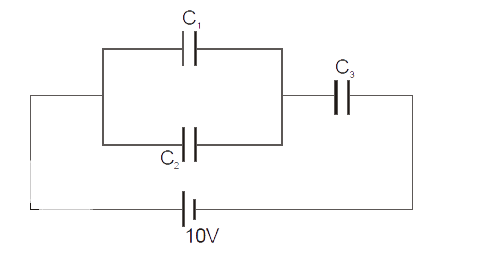A circuit is shown in figure for which C1=(3±0.011)μF,C2=(5±0.01)μFandC3=(1±0.01)μF. If C is the equivalent capacitance across AB, then C is given by

(0.9±0.114)μF
(0.9±0.01)μF
(0.9μ0.023)μF
(0.9μ0.09)μF
The correct Answer is:C
The capacitor C2 is shorted, so it is not playing any role in circuit and can be removed. The 3 capacitors each of C1 are connected in parallel and this is connected to C3 in series.
Ceq=3C1C33C1+C3=C
=3×3×13×3+1=0.9μF
So, ΔCC=3ΔC1C1+ΔC3C3+3ΔC1+ΔC33C1+C3
[For computaion of errors worst has to be taken]
⇒ ΔC0.9=3×0.0113+0.011+(0.033+0.01)10
⇒ ΔC=±0.023μF
Topper's Solved these Questions
- ELECTROSTATICSBOOK - MHTCET PREVIOUS YEAR PAPERS AND PRACTICE PAPERSCHAPTER - ELECTROSTATICSEXERCISE - MHT CET Corner
29 Videos
- ELECTROSTATICSBOOK - MHTCET PREVIOUS YEAR PAPERS AND PRACTICE PAPERSCHAPTER - ELECTROSTATICSEXERCISE - PRACTICE EXERCISE (Exercise 1 (TOPICAL PROBLEMS))
87 Videos
- ELECTRONS AND PROTONSBOOK - MHTCET PREVIOUS YEAR PAPERS AND PRACTICE PAPERSCHAPTER - ELECTRONS AND PROTONSEXERCISE - MHT CET CORNER
19 Videos
- FORCEBOOK - MHTCET PREVIOUS YEAR PAPERS AND PRACTICE PAPERSCHAPTER - FORCEEXERCISE - Exercise 2 (Miscellaneous Problems)
19 Videos
Similar Questions
Knowledge Check
In the given network capacitance, C1=10μF,C2=5μF and C3=4μF. What is the resultant capacitance between A and B?
 A2.2μFB3.2μFC1.2μFD4.7μF
A2.2μFB3.2μFC1.2μFD4.7μFIn, given C1=3μF,C2=5μF,C3=9μF, and C4=13μF. What is the potential differnce between points A and B?
 .A13VB9VC0VD11V
.A13VB9VC0VD11V
In the given network capacitance, C1=10μF,C2=5μF and C3=4μF. What is the resultant capacitance between A and B?

View SolutionIn the given figure the values of five capacitors are C1=C2=C3=C4=2μFandC5=5μF. Find the equivalent capacitance between points P and Q.

View SolutionIn the circuit shown the capacitors are C1=15μF,C2=10μFandC3=25μF. Find

the potential difference across each capacitor.
View SolutionIn the circuit shown the capacitors are C1=15μF,C2=10μFandC3=25μF. Find

the charge on each capacitor and
View SolutionIn, given C1=3μF,C2=5μF,C3=9μF, and C4=13μF. What is the potential differnce between points A and B?
 .
.
View Solution
(i) Find the equivalent capacitance of the combination shown in the figure (a), when C1=2.0μF,C2=4.0μFandC3=3.0μF
(ii) The input terminals A and B in Fig. (a) are connected to a battery of 12 V. Find the potential and the charge of each capacitor.
View Solution

